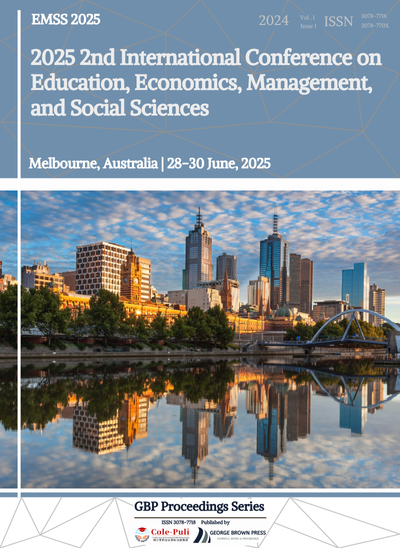Transnational Fan Culture and Cultural Identity: The Iron Man Series and Chinese Cinema Market Dynamics in Cross-Cultural Media Exchange
DOI:
https://doi.org/10.71222/mbj97j69Keywords:
transnational fan culture, Chinese cinema, Iron Man series, cross-cultural communication, cultural identity, Hollywood globalizationAbstract
This study examines the intersection of transnational fan culture and cultural identity through the lens of the Iron Man series' reception in the Chinese cinema market. By analyzing the complex dynamics between Hollywood's globalization strategies and Chinese audiences' cultural responses, this research investigates how transnational media franchises navigate cross-cultural communication while fostering fan communities that transcend geographical and cultural boundaries. Through textual analysis and discourse analysis methodologies, this research explores how the Iron Man series serves as a vehicle for understanding broader patterns of cultural exchange, identity formation, and market adaptation in the contemporary global media landscape. The findings reveal that nearly half of audiences for superhero films are women in China, with a majority of consumers of superhero film-related products also being women, indicating significant gendered patterns in transnational fan engagement. This research contributes to the growing body of literature on transnational cinema studies while providing practical insights for media industries seeking to engage cross-cultural audiences effectively.
References
1. M. S. S. Al-Maliki, "Cultural bridges in film: Evolving Perspectives of Transnational Cinema," Front. Commun., vol. 10, p. 1614642, 2025, doi: 10.3389/fcomm.2025.1614642.
2. C. Berry, "What is transnational Chinese cinema today? Or, welcome to the sinosphere," Transnat. Screens, vol. 12, no. 3, pp. 183–198, 2021, doi: 10.1080/25785273.2021.1991644.
3. X. Zhang, "Why most Chinese fans of American superhero movies are girls: A gendered local fandom of a global Hollywood icon," J. Int. Intercult. Commun., vol. 15, no. 2, pp. 148–164, 2022, doi: 10.1080/17513057.2020.1870709.
4. R. Curry, "Transnational and Diasporic Cinema," Oxford Bibliographies in Cinema and Media Studies, Oxford University Press, 2016, doi: 10.1093/obo/9780199791286-0243.
5. M. Curtin, "Chinese media and globalization," Chin. J. Commun., vol. 5, no. 1, pp. 1–9, 2012, doi: 10.1080/17544750.2011.647737.
6. D. H. Fleming and M. E. Indelicato, "Introduction: on transnational Chinese cinema (s), hegemony and Huallywood (s)," Transnat. Screens, vol. 10, no. 3, pp. 137–147, 2019, doi: /10.1080/25785273.2019.1681650.
7. W. Guo, "Navigating cultural integration: the role of social media among Chinese students in the UK," J. Knowl. Econ., pp. 1–32, 2024, doi: 10.1007/s13132-024-02111-8.
8. S. Hall, "Encoding—Decoding (1980)," in Crime and media, Routledge, 2019, pp. 44–55.
9. Q. Han, "Negotiating identity in the diasporic space: transnational Chinese cinema and Chinese Americans," Continuum, vol. 32, no. 2, pp. 224–238, 2018, doi: 10.1080/10304312.2017.1301380.
10. A. A. Hozic, Hollyworld: Space, power, and fantasy in the American economy, Cornell University Press, 2001.
11. H. Jenkins and M. Deuze, "Convergence culture," Convergence, vol. 14, no. 1, pp. 5–12, 2008, doi: 10.1177/1354856507084415.
12. K. Iwabuchi, Recentering globalization: Popular culture and Japanese transnationalism, Duke University Press, 2002.
13. C. Liu, "An Analysis of Innovative Development Based on Computer Assisted in Promoting the International Transmission of Chinese Culture under the Background of Big Data," Appl. Artif. Intell., vol. 37, no. 1, p. 2201518, 2023, doi: 10.1080/08839514.2023.2201518.
14. Y. Ni, "Navigating Intercultural Communication in the Media Landscape: Challenging Stereotypes and Cultivating Critical Perspectives—Hall Model as the Framework," Digital Soc., vol. 3, no. 2, p. 36, 2024, doi: 10.1007/s44206-024-00126-x.
15. R. Stam, World literature, transnational cinema, and global media: Towards a transartistic commons, Routledge, 2019.
16. X. Song, "Hollywood movies and China: Analysis of Hollywood globalization and relationship management in China’s cinema market," Glob. Media China, vol. 3, no. 3, pp. 177–194, 2018, doi: 10.1177/2059436418805538.
17. J. D. Straubhaar, "Beyond media imperialism: Assymetrical interdependence and cultural proximity," Crit. Stud. Media Com-mun., vol. 8, no. 1, pp. 39–59, 1991, doi: 10.1080/15295039109366779.
18. N. Talmacs, "Chinese cinema and Australian audiences: an exploratory study," Media Int. Aust., vol. 175, no. 1, pp. 50–64, 2020, doi: 10.1177/1329878X20908083.
19. S. Tindi and C. N. Ayiku, "Local reception of global media texts: Telenovelas as sites of cultural mixture in Ghana," Legon J. Humanit., vol. 29, no. 1, pp. 259–282, 2018, doi: 10.4314/ljh.v29i1.10.
20. D. Yuna et al., "Cross-cultural communication on social media: Review from the perspective of cultural psychology and neu-roscience," Front. Psychol., vol. 13, p. 858900, 2022, doi: 10.3389/fpsyg.2022.858900.
21. K. Zhang et al., "Which side do you support? Cultural proximity and media information exposure in affecting Chinese atti-tudes towards Russia-Ukraine war," Curr. Psychol., vol. 43, no. 38, pp. 30366–30378, 2024, doi: 10.1007/s12144-024-06663-5.
Downloads
Published
Issue
Section
License
Copyright (c) 2025 Zhuoling Zheng (Author)

This work is licensed under a Creative Commons Attribution 4.0 International License.



